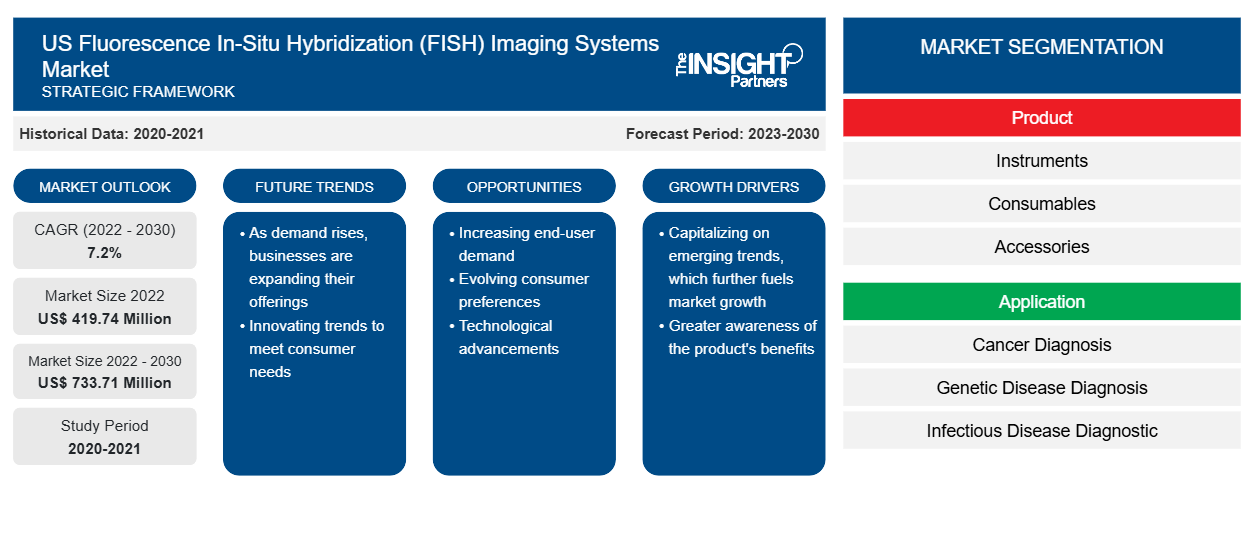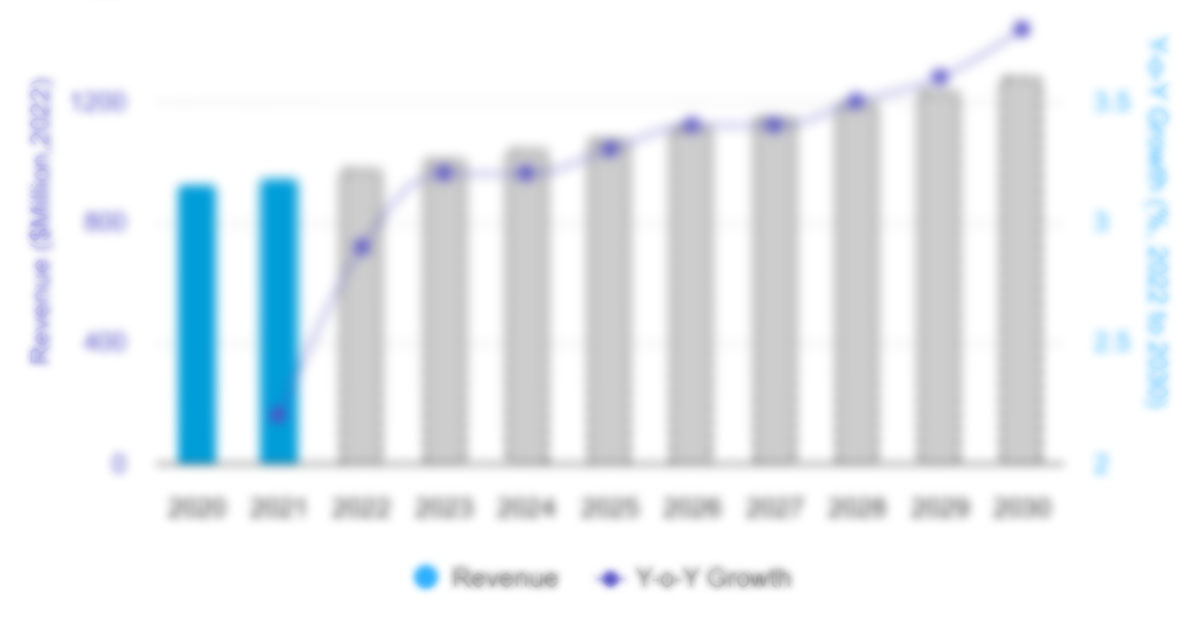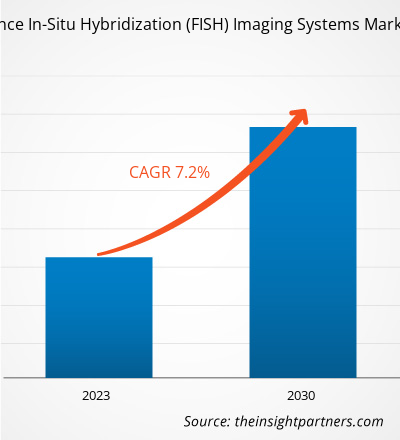The US Fluorescence In-Situ Hybridization (FISH) Imaging Systems market is expected to grow from US$ 419.74 million in 2022 and is expected to reach a value of US$ 733.71 million by 2030; it is anticipated to record a CAGR of 7.2% from 2022 to 2030.
Market Insights and Analyst View:
Fluorescence in situ hybridization (FISH) is a molecular technique for cytogenetic analysis. This technique uses fluorescent probes that bind to only particular parts of a nucleic acid sequence with a high degree of sequence complementarity. FISH detects the presence or absence of specific DNA sequences on chromosomes. FISH is often used to find specific features in DNA/RNA targets for medicine, genetic counseling, and species identification. Key factors driving the fluorescence in-situ hybridization (FISH) imaging systems market growth include the rising prevalence of target disorders and increasing R&D investments in in-vitro diagnostics. However, the high cost of FISH imaging systems and procedures hinders the market growth.
Growth Drivers and Restraints:
FISH is a powerful molecular cytogenetic technique that allows the visualization and localization of specific DNA sequences within cells or tissues. This technology has revolutionized the field of genetics and diagnostics, providing researchers and clinicians with valuable insights into genetic abnormalities, chromosomal rearrangements, and various diseases. The increasing prevalence of target disorders such as genetic syndromes, cancer, and other genetic anomalies drives the demand for FISH imaging systems. According to the National Library of Medicine, the US is expected to record 1.96 new cancer cases and 609,820 cancer deaths in 2023. The demand for accurate and reliable diagnostic tools surges with the continued rise in the prevalence of these target disorders. FISH imaging systems provide high-resolution images to aid the detection of subtle genetic changes, enabling early disease diagnosis and personalized treatment approaches. These disorders often involve genetic mutations or variations that can be accurately identified and characterized using FISH imaging systems. The ability to precisely map the location of specific genes or DNA sequences within cells has proven crucial for understanding disease mechanisms, developing targeted therapies, and making informed clinical decisions.
A prominent advantage of FISH lies in its ability to work with various sample types, including formalin-fixed paraffin-embedded tissues, cytological preparations, and fresh tissues. This versatility has made FISH an essential tool in both research and clinical settings, allowing the identification of genetic markers associated with diseases such as leukemia, lymphoma, solid tumors, and congenital disorders.
The fluorescence in situ hybridization (FISH) imaging systems market is further driven by continued investments in research and development (R&D) activities related to in-vitro diagnostics (IVD). With its unique capability to visualize specific DNA sequences within cellular environments, the FISH technique has emerged as a key procedure in modern diagnostics, particularly in detecting genetic disorders and rare diseases. An upsurge in R&D funding in IVD has catalyzed transformative advancements in FISH imaging systems by allowing researchers to create cutting-edge platforms providing enhanced image quality with features supporting streamlined automation, culminating in more accurate and rapid diagnostic processes. PNA FISH, a novel diagnostic method that uses FISH with peptide nucleic acid (PNA) probes, combines the ease of traditional staining procedures with the exceptional performance of PNA probes to provide rapid and accurate diagnoses of contagious diseases, which makes PNA FISH suitable for routine application and enables clinical microbiology laboratories to report important information for patient therapy within a time frame that is not possible using classic biochemical methods.
However, FISH imaging analysis is a less commonly used method in cancer detection owing to its relatively higher cost than other methods. In addition to the equipment cost, the expenses associated with reagents, other consumables, and specialized personnel appointments can add to the overall cost of evaluation based on FISH imaging. For instance, the detection of ALK gene non-small cell lung cancer by IHC costs US$ 90.07 in the US for every test, which is less than either independent or parallel testing by FISH and IHC (costing ~US$ 441.85 in the US). Thus, the high cost of procedures and systems limits the growth of the fluorescence in situ hybridization (FISH) imaging systems market.
Customize This Report To Suit Your Requirement
You will get customization on any report - free of charge - including parts of this report, or country-level analysis, Excel Data pack, as well as avail great offers and discounts for start-ups & universities
US Fluorescence In-Situ Hybridization (FISH) Imaging Systems Market: Strategic Insights

- Get Top Key Market Trends of this report.This FREE sample will include data analysis, ranging from market trends to estimates and forecasts.
Customize This Report To Suit Your Requirement
You will get customization on any report - free of charge - including parts of this report, or country-level analysis, Excel Data pack, as well as avail great offers and discounts for start-ups & universities
US Fluorescence In-Situ Hybridization (FISH) Imaging Systems Market: Strategic Insights

- Get Top Key Market Trends of this report.This FREE sample will include data analysis, ranging from market trends to estimates and forecasts.
Report Segmentation and Scope:
The “US Fluorescence In-Situ Hybridization (FISH) Imaging Systems Market” is segmented on the basis of the product, application, and end user. Based on product, the market is segmented into instruments, consumables, accessories, and software. In terms of application, the fluorescence in-situ hybridization (FISH) imaging systems market is segmented into cancer diagnosis, genetic disease diagnosis, infectious disease diagnosis, and others. Based on end user, the market is segmented into diagnostic laboratories, contract research organizations, pharmaceutical and biotechnological companies, and others.
- This FREE sample will include data analysis, ranging from market trends to estimates and forecasts.
Segmental Analysis:
The US fluorescence in-situ hybridization (FISH) imaging systems market, by product, is segmented into instruments, consumables, accessories, and software. The consumables segment held the largest market share in 2022 and is anticipated to register the highest CAGR during 2022–2030. Consumables are the most promising segment of the fluorescence in-situ hybridization (FISH) imaging system market that will contribute to tremendous growth in the coming years. FISH consumables include hybridization buffers, probes, tag detection kits, signal amplification detection kits, and others. The presence of manufacturers such as Abbott, F. Abnova, and Thermo Fisher Scientific bolsters the market for the consumables segment. These products are frequently used in various research diagnosis processes, which is expected to propel consumption. Thus, the presence of various market players offering probes & kits and technological advancements by market players are likely to propel the market for the segment in the coming years.
Fluorescence In-Situ Hybridization (FISH) Imaging Systems Market, by Products – 2022 and 2030


- This FREE sample will include data analysis, ranging from market trends to estimates and forecasts.
Based on application, the fluorescence in-situ hybridization (FISH) imaging systems market is segmented into cancer diagnosis, genetic disease diagnosis, infectious disease diagnosis, and others. The cancer diagnosis segment held the largest market share in 2022 and is anticipated to register the highest CAGR during 2022–2030. FISH technology has tremendously benefited cancer diagnosis. FISH imaging systems can look for gene changes and help detect anomalies. According to Cancer Research UK, FISH testing is used for the diagnosis of several cancers, including breast cancer, lymphoma, lung cancer, prostate cancer, chronic lymphocytic leukemia (CLL), acute lymphoblastic leukemia (ALL), acute myeloid leukemia (AML), chronic myeloid leukemia (CML), myeloma, Ewings sarcoma, and melanoma skin cancer.
Based on end user, the fluorescence in-situ hybridization (FISH) imaging systems market is segmented into diagnostic laboratories, contract research organization, pharmaceutical and biotechnological companies, and others. The diagnostic laboratories segment held the largest market share in 2022 and is anticipated to register the highest CAGR during 2022–2030. The diagnostic laboratories are involved in various research projects to develop several technologies and products for fluorescence in-situ hybridization (FISH) imaging processes. Unprecedented developments in research and technologies have created the potential for transformation in the healthcare and life sciences sectors. The clinical applications of fluorescence in-situ hybridization (FISH) imaging systems are vast and offer opportunities to enhance diagnosis and treatment capabilities for chronic disease. They offer huge potential in gene discovery and diagnosis of rare genetic disorders. The technologies are increasingly used to analyze rare and common genetic factors influencing the development of common diseases, such as cancer, high blood pressure, diabetes, and renal diseases.
Fluorescence In-Situ Hybridization (FISH) Imaging Systems Market Opportunity:
FISH imaging systems are witnessing a remarkable evolution due to the surge in technological advancements, which result in cutting-edge innovations transforming the landscape of genetic research and diagnostics. These advancements include enhanced optics, more sensitive and versatile fluorophores, and sophisticated automation features. Modern FISH imaging systems, integrated with these upgraded features, offer greater sensitivity, improved image resolution, and faster processing times. Moreover, these technological advancements have extended the application scope of FISH imaging from cancer diagnosis to genetic predisposition testing. In April 2023, Agilent Technologies Inc had formed a partnership with PathAI. The partnership enabled the Agilent and PathAI to build integrated solutions with assays and machine learning analysis algorithms. Similarly, in May 2023, Pfizer and Thermo Fisher Scientific Inc entered into a collaboration agreement to help increase local access to next-generation sequencing (NGS)-based testing for lung and breast cancer patients in over 30 countries across Latin America, Africa, the Middle East, and Asia where advanced genomic testing was previously limited or unavailable. Access to local NGS testing can help enable faster analysis of related genes, allowing healthcare providers to choose the best medicine for that specific patient. Thus, technological advancements in FISH imaging systems create significant opportunities for companies in the fluorescence in situ hybridization (FISH) imaging systems market.
Country Analysis:
The US is estimated to hold the largest fluorescence in-situ hybridization (FISH) imaging systems market share during the forecast period. The growing demand for advanced diagnostic tools in molecular genetics and cytogenetics and the rising prevalence of genetic disorders and cancer fuel the adoption of fluorescence in-situ hybridization (FISH) imaging systems in the US. As per data published by the American Cancer Society in 2022, nearly 1.9 million cancer cases were diagnosed and 609,360 cancer deaths were reported in the US. These systems offer high-resolution imaging of genetic material, enabling researchers and clinicians to detect chromosomal abnormalities and gene mutations with greater accuracy. Furthermore, the increasing focus on personalized medicine and targeted therapies has led to an upsurge in research activities involving genetic analysis, bolstering the demand for FISH imaging systems. The ability of these systems to provide detailed spatial information on gene sequences directly within cells has proven invaluable in both research and clinical applications. The FISH imaging systems have recently gained immense popularity due to their technological advancements such as improved automation, higher throughput, and enhanced image analysis software. As a result, laboratories and medical institutions are better equipped to handle larger volumes of samples and generate precise results efficiently. Thus, the growing demand for advanced diagnostic tools in molecular genetics and cytogenetics and the rising prevalence of genetic disorders and cancer bolster the fluorescence in-situ hybridization (FISH) imaging systems market in the US.
Industry Developments and Future Opportunities:
Various initiatives taken by key players operating in the US fluorescence in-situ hybridization (FISH) imaging systems market are listed below:
- In May 2023, Pfizer and Thermo Fisher Scientific Inc collaborated to help increase local access to next-generation sequencing (NGS)-based testing for lung and breast cancer patients in over 30 countries across Latin America, Africa, the Middle East, and Asia where advanced genomic testing was previously limited or unavailable. Access to local NGS testing can help enable faster analysis of related genes, allowing healthcare providers to choose the best medicine for that specific patient.
- In April 2023, Agilent Technologies Inc signed a memorandum of understanding with Theragen Bio in South Korea. As part of the partnership agreement, Agilent and Theragen Bio combined their strengths in cancer genomic profiling design, engineering knowledge, and software expertise to drive localized analysis capabilities and accelerate treatment decisions.
- In January 2023, Thermo Fisher Scientific Inc, the world leader in serving science, had completed its acquisition of The Binding Site Group, a global leader in specialty diagnostics, from a shareholder group led by Nordic Capital in an all-cash transaction valued at GBP 2.3 billion, or US$ 2.8 billion at current exchange rates. The Binding Site adds pioneering innovation in diagnosis and monitoring for multiple myeloma to the existing specialty diagnostics portfolio. Early detection and informed treatment decisions can substantially impact patient outcomes.
- In December 2021, BioGenex Laboratories Inc launched three new primary immunohistochemistry (IHC) antibodies for cancer diagnostics—CD8A, CD56, and CD163.
- In April 2021, Applied Spectral Imaging (ASI) and KromaTiD Inc had entered a strategic commercial partnership, allowed ASI worldwide rights to market KromaTiD’s proprietary Pinpoint FISH (PPF) probes and assay services.
Competitive Landscape and Key Companies:
Euroclone SpA, TissueGnostics GmbH, Agilent Technologies Inc, Abnova Taiwan Corp, BioGenex Laboratories Inc, Leica Biosystems Nussloch GmbH, MetaSystems Probes GmbH, Bio-View Ltd, Thermo Fisher Scientific Inc, Applied Spectral Imaging, and PerkinElmer Inc are among the prominent players operating in the fluorescence in-situ hybridization (FISH) imaging systems market. These companies focus on new technologies, advancements in existing products, and geographic expansions to meet the growing consumer demand worldwide and increase their product range in specialty portfolios.
US Fluorescence In-Situ Hybridization (FISH) Imaging Systems Report Scope
| Report Attribute | Details |
|---|---|
| Market size in 2022 | US$ 419.74 Million |
| Market Size by 2030 | US$ 733.71 Million |
| Global CAGR (2022 - 2030) | 7.2% |
| Historical Data | 2020-2021 |
| Forecast period | 2023-2030 |
| Segments Covered |
By Product
|
| Regions and Countries Covered | United States
|
| Market leaders and key company profiles |
- Historical Analysis (2 Years), Base Year, Forecast (7 Years) with CAGR
- PEST and SWOT Analysis
- Market Size Value / Volume - Global, Regional, Country
- Industry and Competitive Landscape
- Excel Dataset



Report Coverage
Revenue forecast, Company Analysis, Industry landscape, Growth factors, and Trends

Segment Covered
Product, Application, and End User

Regional Scope
North America, Europe, Asia Pacific, Middle East & Africa, South & Central America

Country Scope
This text is related
to country scope.
Frequently Asked Questions
Fluorescence in situ hybridization (FISH) is a molecular technique for cytogenetic analysis. This technique uses fluorescent probes that bind to only particular parts of a nucleic acid sequence with a high degree of sequence complementarity. FISH detects the presence or absence of specific DNA sequences on chromosomes. FISH is often used to find specific features in DNA/RNA targets for medicine, genetic counseling, and species identification.
Factors such as the rising prevalence of target disorders and the increasing R&D investments in in-vitro diagnostics propel market growth.
The fluorescence in-situ hybridization (FISH) imaging systems market majorly consists of the players, including Euroclone SpA, TissueGnostics GmbH, Agilent Technologies Inc, Abnova Taiwan Corp, BioGenex Laboratories Inc, Leica Biosystems Nussloch GmbH, MetaSystems Probes GmbH, Bio-View Ltd, Thermo Fisher Scientific Inc, Applied Spectral Imaging, and PerkinElmer Inc.
The fluorescence in-situ hybridization (FISH) imaging systems market was valued at US$ 419.74 million in 2022.
The fluorescence in-situ hybridization (FISH) imaging systems market, by end user, is segmented into diagnostic laboratories, contract research organizations, pharmaceutical and biotechnological companies, and others. The diagnostic laboratories segment held a larger market share in 2022, and the same segment is anticipated to register a higher CAGR.
The fluorescence in-situ hybridization (FISH) imaging systems market is expected to be valued at US$ 733.71 million in 2030.
The US fluorescence in-situ hybridization (FISH) imaging systems market, by application, is segmented into cancer diagnosis, genetic disease diagnosis, infectious disease diagnosis, and others. The cancer diagnosis segment held a larger market share in 2022, and the same segment is anticipated to register a higher CAGR.
The fluorescence in-situ hybridization (FISH) imaging systems market, by services, is segmented into pharmacokinetics, biomarkers, immunogenicity, virology testing, cell-based assays, and others. The cell-based assays segment held a larger market share in 2022. Also, the same segment is anticipated to register a higher CAGR.
Trends and growth analysis reports related to Life Sciences : READ MORE..
The List of Companies - U.S. Fluorescence In-Situ Hybridization (FISH) Imaging Systems Market
- Euroclone SpA
- TissueGnostics GmbH
- Agilent Technologies Inc
- Abnova Taiwan Corp
- BioGenex Laboratories Inc
- Leica Biosystems Nussloch GmbH
- MetaSystems Probes GmbH
- Bio-View Ltd
- Thermo Fisher Scientific Inc
- Applied Spectral Imaging
- PerkinElmer Inc

 Get Free Sample For
Get Free Sample For